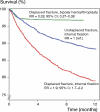Clinical outcome after undisplaced femoral neck fractures
- PMID: 21619501
- PMCID: PMC3235303
- DOI: 10.3109/17453674.2011.588857
Clinical outcome after undisplaced femoral neck fractures
Abstract
Background and purpose: Little attention has been paid to undisplaced femoral neck fractures. By using data from the Norwegian Hip Fracture Register, we investigated the risk of reoperation and the clinical outcome after treatment of these fractures in patients over 60 years of age.
Methods: Data on 4,468 patients with undisplaced femoral neck fractures who were operated with screw osteosynthesis were compared to those from 10,289 patients with displaced femoral neck fractures treated with screw osteosynthesis (n = 3,389) or bipolar hemiarthroplasty (n = 6,900). The evaluation was based on number of reoperations and patient assessment at 4 and 12 months of follow-up.
Results: The 1-year implant survival was 89% after screw fixation for undisplaced fractures, 79% after screw fixation for displaced fractures, and 97% after hemiarthroplasty for displaced fractures. Patients with displaced fractures who were operated with internal fixation had a higher risk of reoperation (RR = 1.9, CI: 1.7-2.2), reported more pain, were less satisfied, and had lower quality of life than patients with undisplaced fractures treated with internal fixation (p < 0.05). Patients with displaced fractures who were operated with hemiarthroplasty had a lower risk of reoperation than patients with undisplaced fractures who were operated with internal fixation (RR = 0.32, CI: 0.27-0.38). Furthermore, they had the lowest degree of pain, were most satisfied, and reported the highest quality of life.
Interpretation: The differences in clinical outcome found were less than what is considered to be of clinical importance. The results support the use of screw osteosynthesis for undisplaced femoral neck fractures in elderly patients, although even better results were obtained in the hemiarthroplasty group in patients with displaced fractures.
Figures



Comment in
-
Preoperative posterior tilt of at least 20° increased the risk of fixation failure in Garden-I and -II femoral neck fractures.Acta Orthop. 2016 Jun;87(3):252-6. doi: 10.3109/17453674.2016.1155253. Epub 2016 Mar 3. Acta Orthop. 2016. PMID: 26937557 Free PMC article.
References
-
- Baker RP, Squires B, Gargan MF, Bannister GC. Total hip arthroplasty and hemiarthroplasty in mobile, independent patients with a displaced intracapsular fracture of the femoral neck. A randomized, controlled trial. J Bone Joint Surg (Am) 2006;88:2583–9. - PubMed
-
- Bjorgul K, Reikeras O. Outcome of undisplaced and moderately displaced femoral neck fractures. Acta Orthop. 2007;78(4):498–504. - PubMed
-
- Blomfeldt R, Tornkvist H, Ponzer S, Soderqvist A, Tidermark J. Internal fixation versus hemiarthroplasty for displaced fractures of the femoral neck in elderly patients with severe cognitive impairment. J Bone Joint Surg (Br) 2005;87:523–9. - PubMed
-
- Brooks R. EuroQol: the current state of play. Health Policy. 1996;37:53–72. - PubMed
-
- Conn KS, Parker MJ. Clin Orthop. (421) 2004. Undisplaced intracapsular hip fractures: results of internal fixation in 375 patients; pp. 249–54. - PubMed
Publication types
MeSH terms
LinkOut - more resources
Full Text Sources
Medical
